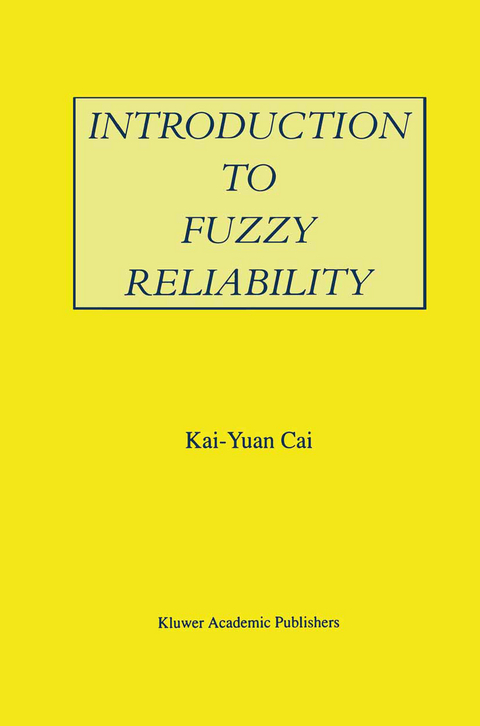
Introduction to Fuzzy Reliability
Springer-Verlag New York Inc.
978-1-4612-8608-0 (ISBN)
Introduction to Fuzzy Reliability treats fuzzy methodology in hardware reliability and software reliability in a relatively systematic manner. The contents of this book are organized as follows. Chapter 1 places reliability engineering in the scope of a broader area, i.e. system failure engineering. Readers will find that although this book is confined to hardware and software reliability, it may be useful for other aspects of system failure engineering, like maintenance and quality control. Chapter 2 contains the elementary knowledge of fuzzy sets and possibility spaces which are required reading for the rest of this book. This chapter is included for the overall completeness of the book, but a few points (e.g. definition of conditional possibility and existence theorem of possibility space) may be new. Chapter 3 discusses how to calculate probist system reliability when the component reliabilities are represented by fuzzy numbers, and how to analyze fault trees when probabilities of basic events are fuzzy. Chapter 4 presents the basic theory of profust reliability, whereas Chapter 5 analyzes the profust reliability behavior of a number of engineering systems. Chapters 6 and 7 are devoted to probist reliability theory from two different perspectives. Chapter 8 discusses how to model software reliability behavior by using fuzzy methodology. Chapter 9 includes a number of mathematical problems which are raised by applications of fuzzy methodology in hardware and software reliability, but may be important for fuzzy set and possibility theories.
1 Introduction.- 1.1 System Failure Engineering.- 1.2 Understanding Uncertainty.- 1.3 Why Fuzzy Methodology in System Failure Engineering.- 1.4 Overview on Fuzzy Methodology in System Failure Engineering.- References.- 2 Fuzzy Sets and Possibility Spaces.- 2.1 Fuzzy Sets.- 2.2 Fuzzy Numbers.- 2.3 Possibility Spaces and Conditional Possibility.- 2.4 Possibilistic Variables.- 2.5 Existence Theorem of Possibility Space.- References.- 3 Fuzzy Methods in Probist Systems.- 3.1 Probist Reliability as a Fuzzy Number.- 3.2 Fuzzy Probist System Reliability.- 3.3 Fuzzy Probist Fault Tree Analysis.- References.- 4 Profust Reliability Theory.- 4.1 Basic Concepts.- 4.2 Typical Systems.- 4.3 Mixture Models.- 4.4 Coherent Systems.- References.- 5 Profust Reliability Behavior of Engineering Systems.- 5.1 Street-Lighting Lamps Replacement Problem.- 5.2 Gracefully Degradable Computing Systems.- 5.3 Computer Communication Networks.- 5.4 Computer Integrated Manufacturing Systems.- 5.5 Fly-by-Wire Control Systems.- References.- 6 Posbist Reliability Theory in Terms of System Lifetimes.- 6.1 System Lifetimes.- 6.2 Series Systems.- 6.3 Parallel Systems.- 6.4 Coherent Systems.- 6.5 Fault-Tolerant Systems.- References.- 7 Posbist Reliability Theory in Terms of System States.- 7.1 System States.- 7.2 Series Systems.- 7.3 Parallel Systems.- 7.4 Coherent Systems.- 7.5 Reliability Importance.- 7.6 Typical Systems with Two Types of Failures.- References.- 8 Fuzzy Methods in Software Reliability Modeling.- 8.1 Continuous-Time Software Reliability Modeling.- 8.2 Reliability Behavior of Flight Control Software.- 8.3 Software Reliability Validation.- 8.4 Discrete-Time Software Reliability Modeling.- 8.5 Combined Hardware-Software Reliability Modeling.- References.- 9 Mathematical Problems.- References.-Appendix 2 Liu-Huang Algorithm.- Appendix 3 Software Reliability Data.
| Reihe/Serie | The Springer International Series in Engineering and Computer Science ; 363 |
|---|---|
| Zusatzinfo | XVII, 311 p. |
| Verlagsort | New York, NY |
| Sprache | englisch |
| Maße | 155 x 235 mm |
| Themenwelt | Mathematik / Informatik ► Informatik ► Software Entwicklung |
| Informatik ► Theorie / Studium ► Künstliche Intelligenz / Robotik | |
| Mathematik / Informatik ► Mathematik ► Allgemeines / Lexika | |
| Mathematik / Informatik ► Mathematik ► Angewandte Mathematik | |
| Mathematik / Informatik ► Mathematik ► Logik / Mengenlehre | |
| ISBN-10 | 1-4612-8608-5 / 1461286085 |
| ISBN-13 | 978-1-4612-8608-0 / 9781461286080 |
| Zustand | Neuware |
| Informationen gemäß Produktsicherheitsverordnung (GPSR) | |
| Haben Sie eine Frage zum Produkt? |
aus dem Bereich


